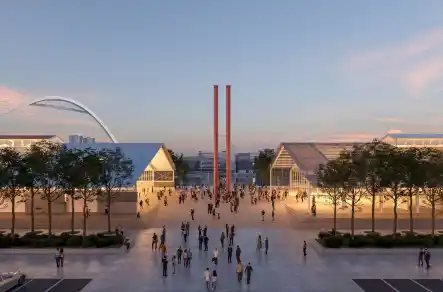Park Golf in Busan: Urban Aging, Land Use, and Intergenerational Design
As aging accelerates, Busan is building dozens of park golf courses. But are they designed for the future — or just the elderly?

BUSAN, South Korea — As of April 2025, 23.9% of Busan’s population — approximately 780,576 individuals — is aged 65 or older, a figure significantly higher than the national average of 20%. In response to this demographic trend, local governments in Busan have actively promoted park golf as a public health and leisure initiative for older adults.
Currently, 17 park golf courses are operating across the city, and the municipal government plans to expand this number to 54 in the coming years. At least 10 district offices are either constructing new facilities or conducting feasibility studies, often utilizing idle public land or underused green spaces.
While the expansion is framed as part of a senior-friendly urban policy, concerns have been raised regarding site accessibility, overlapping land use, and the long-term sustainability of single-purpose facilities. These developments highlight the broader challenges of urban planning in rapidly aging cities.
Busan’s Expansion Strategy: Scope, Speed, and Site Selection
Park golf infrastructure in Busan has expanded steadily in recent years, reflecting both demographic pressure and political momentum. As of early 2025, the city operates 17 public park golf courses comprising a total of 342 holes. Municipal authorities have announced plans to increase this number to 54 courses, with a corresponding rise in hole capacity to 689. This ambitious growth trajectory underscores the degree to which park golf has been institutionalized as a response to population aging.
District governments have played a central role in this expansion. At least ten of Busan’s sixteen administrative districts are currently engaged in either the construction of new facilities or the preparatory stages of development, such as site assessments and design studies. In densely populated urban centers with limited available land — including Dong-gu and Jung-gu — proposals have focused on repurposing public parks or existing green spaces. In more peripheral districts such as Gangseo-gu and Gijang-gun, projects are being pursued on larger plots of idle municipal land, including ecological reserves and underutilized waterfront zones.
While the city’s strategy has emphasized speed and efficiency — often citing the relatively low cost of park golf course development — this approach has not been without controversy. Urban planning experts and civic organizations have raised concerns about the lack of comprehensive demand analysis and the absence of community consultation in many of the site selection processes. Accessibility has emerged as a particular point of contention, with critics noting that several new facilities are located in areas poorly served by public transportation, thus limiting their utility for the very demographic they are intended to serve.
In addition, some residents have objected to the conversion of shared public spaces into specialized recreational zones. This has prompted debates about the appropriate balance between single-use and multi-functional public land, especially in a city where open green space is already unevenly distributed.
Although the city continues to justify its investment in park golf on the basis of demographic need and public health, the current trajectory raises questions about spatial equity, land use planning, and long-term sustainability. These issues form the backdrop against which Busan’s park golf strategy must now be evaluated.
Global Variations in Design and Purpose of Park Golf
While park golf is relatively new to South Korea’s urban policy toolkit, its roots lie in Japan, where the sport was first developed in 1983 as a health initiative for older adults in Hokkaido. In the decades since, Japan has expanded park golf into a mainstream recreational option. With over 1,200 courses nationwide and a user base that exceeds one million, the sport has gradually evolved from a senior-focused intervention into a multigenerational leisure activity. Many Japanese municipalities now incorporate park golf into broader park planning, allowing courses to coexist with walking trails, playgrounds, and civic gathering spaces. This model reflects a shift from age-segregated amenities toward more inclusive, integrated public space design.
Elsewhere, park golf has been adopted with different social and spatial priorities. In the United States, for example, community park systems in states such as New York, Illinois, and Ohio have introduced park golf as a recreational option within existing public parks. These initiatives tend to emphasize inclusivity across age groups, encouraging families, youth, and retirees to engage together. Rather than being labeled as senior sports infrastructure, park golf in these contexts is framed as a casual, entry-level sport that supports everyday outdoor activity.
In Canada, particularly in smaller towns and tourism-oriented regions, park golf has been introduced as a form of eco-friendly leisure. Courses are often situated in nature parks or near campgrounds and are marketed as low-intensity recreation suitable for all ages. Similarly, in parts of Central Europe, public golf facilities have experimented with scaled-down park golf features, often as part of multi-use recreational zones.
Across these contexts, a common thread emerges: park golf is most successful when it is not confined to a single demographic or spatial logic. Instead, it thrives when implemented as a flexible, socially open, and physically integrated component of public life. This stands in contrast to the prevailing model in Busan, where park golf facilities are frequently treated as standalone, age-targeted investments. The divergence highlights a core tension in policy design — between accommodating immediate demographic needs and creating lasting, adaptable public infrastructure.
Reframing Park Golf as Shared Civic Infrastructure
🎯 Park Golf as a Family Sport
Park golf isn't just for seniors. Its low-intensity nature and simple rules make it ideal for children, teens, and multi-generational families.
Urban designers see it as a shared leisure platform — one that fosters inclusion, not separation.
The expansion of park golf in Busan offers a timely lens through which to examine the city’s approach to aging, spatial equity, and public infrastructure. While the development of park golf facilities has been justified on the grounds of demographic need and relatively low implementation costs, the current model exhibits characteristics of reactive rather than strategic planning. In particular, the prevailing tendency to treat park golf as a senior-exclusive, single-use facility limits its potential both in terms of usage and public value.
International examples indicate that park golf is most effective when it is conceptualized not as an age-segregated sport, but as a socially integrative platform embedded within broader recreational systems. In this regard, Busan’s policy approach could benefit from reorientation along three key lines.
First, spatial integration must be prioritized over geographic dispersal. While utilizing idle land may expedite project delivery, facilities located on the urban periphery risk underuse by the very populations they are intended to serve. Embedding park golf into existing urban parks, especially in areas with high population density and transit access, would increase both accessibility and visibility.
Second, multi-functionality should guide future design. Rather than isolating park golf areas from other forms of public space, planners should explore hybrid layouts that allow for co-location with walking paths, community gardens, and youth facilities. Such integration not only optimizes land use, but also fosters intergenerational interaction and collective ownership of space.
Finally, long-term sustainability requires participatory governance and usage data. To avoid the pattern of enthusiasm followed by neglect — common to many recreational infrastructure projects — Busan’s park golf strategy would benefit from greater community engagement, clearer usage metrics, and adaptive management models. Pilot programs involving schools, family groups, and senior centers could inform design modifications and programming needs.
As cities age, they must innovate not only in services but in how they structure the physical spaces where public life unfolds. Park golf offers one such opportunity — not simply to serve older adults, but to create shared spaces that reflect the full spectrum of urban life.
Planning Beyond Age: Building for Public Life
The rise of park golf in Busan reflects the city’s urgent response to demographic realities that will increasingly define urban governance across South Korea and beyond. As policymakers seek practical, scalable solutions to support aging populations, the attraction of park golf — affordable, accessible, and low-impact — is clear. Yet its long-term value will depend not only on how many courses are built, but on how those spaces are conceived, who they serve, and how they evolve over time.
The critical policy challenge is not whether park golf can improve the quality of life for older adults — it can. Rather, the question is whether it can do so while also contributing to more inclusive, resilient, and socially vibrant public environments. If park golf continues to be developed as a purpose-built, age-exclusive intervention, its utility may prove limited and its maintenance burdensome. Conversely, if integrated into multifunctional public space and designed for intergenerational use, it may become a model for adaptive, human-centered urban aging policy.
Busan, with its advanced demographic profile and dense urban fabric, is uniquely positioned to lead this evolution. The city’s next phase of park golf development presents not just a recreational initiative, but an opportunity to redefine how aging and public space intersect — with potential lessons well beyond its borders.



Comments ()